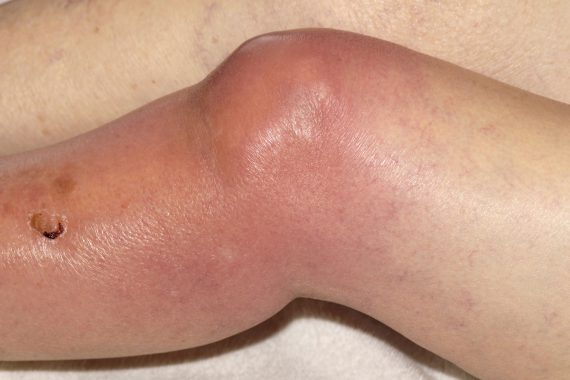Rheumatology clinic – ‘My wrists and knees are killing me’

The case
A 71-year-old lady with insulin-dependent diabetes and rheumatoid arthritis on methotrexate presents to her GP with new pain in her left wrist and knee joints, which she has had for the past three days. She is now using a crutch as she is unable to weight-bear.
On examination she is apyrexial. The left wrist and knee are erythematous, warm, swollen and markedly tender, with a negligible range of movement. There is non-tender swelling of the metacarpophalangeal joints, which move painlessly.
Her GP suspects a diagnosis of septic arthritis and urgently refers her to the emergency department.
The problem
Septic arthritis is joint sepsis caused by pathogenic inoculation of the joint by direct or haematogenous routes.1
Delayed or insufficient treatment can lead to permanent damage and the estimated fatality rate is 11%.2
Risk factors are:
- Having rheumatoid or osteoarthritis.
- Prosthetic joints.
- Intravenous drug use.
- Alcoholism.
- Diabetes.
- Intra-articular steroid injections.
- Cutaneous ulcers.1
If joint sepsis is suspected, the patient should be referred as an emergency to on-call disciplines such as rheumatology, orthopaedics and the emergency department.2
Synovial fluid should be delivered promptly to pathology labs for microscopy and culture, so aspiration should take place in secondary care.
Features
Septic arthritis typically presents with a short – one- to two-week – history of pain, swelling, warmth and restricted movement. More than one joint is affected in up to 22% of cases.4
Diagnosis can be made more difficult by pre-existing inflammatory arthritis, but symptoms are often out of proportion to the disease activity in other joints. There may be a history of recent or concomitant infection elsewhere. Fever is only present in about 60% of cases, so its absence does not preclude the diagnosis.2
Diagnosis
Septic arthritis is a clinical diagnosis and the history and examination are of the utmost importance. Extra-articular infection must also be ruled out.
Investigations performed in secondary care include FBC, U&Es and inflammatory markers. An MRI is done if osteomyelitis is suspected. Anticoagulant therapy is not a contraindication to joint aspiration. Attempts should be made to obtain synovial fluid prior to starting antibiotics, but this should not delay the start of treatment in a systemically unwell patient. Initial gram stains are only positive in around 50% of cases and synovial cultures are often negative in cases treated as septic arthritis.5,6
Management
Treatment is with intravenous antibiotics for a minimum of two weeks with a further four-week oral course. The British Society for Rheumatology guidelines7suggest intravenous flucloxacillin 2g qds or oral clindamycin 450-600mg qds if the patient is allergic to penicillin. Patients at high risk of gram-negative sepsis, such as the elderly, those with recurrent urine infections or those who have had recent abdominal surgery, should be treated with a second or third-generation cephalosporin, while those at risk of MRSA should be treated with vancomycin.
Discussion with a microbiologist is advised in non-standard cases. Patients on disease-modifying or biologic treatments should have these suspended while on antibiotics. Recovery may be prolonged and incomplete, and there is a role for physiotherapy.
Dr Gerald Coakley is a consultant rheumatologist and Dr Laura Attipoe is a rheumatology registrar at the Queen Elizabeth Hospital, south-east London
Key points
Pulse July survey
Take our July 2025 survey to potentially win £1.000 worth of tokens











